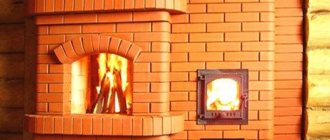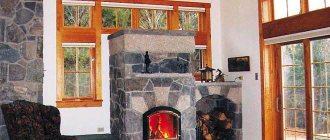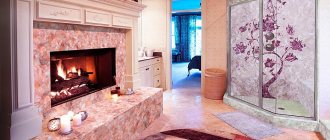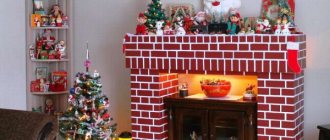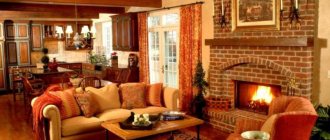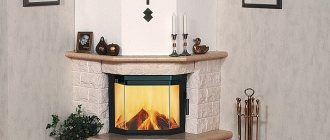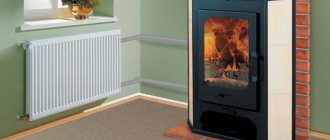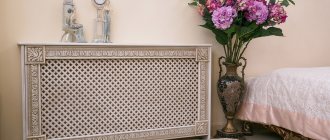In order for the fireplace to take its rightful central place in the house, you need to seriously think about its decoration. After all, he should attract household members with his beauty and comfort. But in addition to aesthetics, the fireplace lining must also have a practical component. An open fire in the hearth is not only comfort and luxury. But also danger. As well as soot and soot from combustion products.
Cladding a fireplace with tiles Source ceramicadecor.ru
Choosing a finishing method
Just the mention of a fireplace in a casual conversation can make a person feel warm. And all because an island of comfort with tongues of living flame immediately appears before your eyes. Where it is very pleasant to while away the cold winter evenings.
Previously, it was believed that only owners of private houses could afford such luxury. Since safety requirements are fully implemented only in such buildings. But with the advent of imitations, electric fireplaces and bio-fireplaces, it became possible to create a comfortable place to relax in any apartment in a multi-storey building.
Moreover, both a real working fireplace and a decorative stylization for it are subject to cladding. And if in ancient times only tiles were used to decorate the hearth, today the choice of materials is truly enormous. Therefore, the developer will involuntarily have to rack his brains about how to veneer the fireplace.
Since the range is really large, it is extremely difficult to name the ideal material. After all, in addition to aesthetics, it is necessary to pay attention to the practical side. Find out how well the chosen option suits the existing design. Because you will need to take into account a lot of factors.
Fireplace in the living room Source ceramicadecor.ru
For example, the type of fireplace and type of fuel. If wood burns in a real hearth, its walls will heat up to very high temperatures. Therefore, a special cladding is needed - heat-resistant. And it’s best to take the material with a margin to spare. Suddenly you want to heat the hearth with coal. And its combustion temperature is higher than that of firewood.
Or provide conditions at the location. It happens that a fireplace is installed on the terrace and used occasionally. The rest of the time the fireplace is in a cold room, where the ambient temperature can drop below zero. It goes without saying that the finishing material must be frost-resistant.
Any combustion releases products such as soot and soot. They settle on the surface and not only spoil the appearance of the room. If you want to lean your elbows on the mantelpiece, then this is fraught with damage to your clothes. Not to mention that you will have to wash it very carefully afterwards. Therefore, we need a cladding that is not afraid of water and is easy to clean regularly.
Fireplace lined with clinker tiles Source festima.ru
You also need to select a material that will fit perfectly into the overall design of the room. After all, no one has canceled simple design rules. And even if you involuntarily disturb the interior, then from the main accent of the room, the fireplace will literally turn into an eyesore.
But most often you have to take into account the weight of the materials. After all, finishing a fireplace with porcelain stoneware is completely impossible if it is a decorative imitation made of cardboard. And not every active fireplace can be covered with natural stone. The significant weight of these materials requires the construction of a reinforced foundation for the structure.
True, such difficulties await only those who want to decorate their recreation area with special luxury. But artificial stone or tiles are light enough to be glued even to a plasterboard frame. And the price will be much cheaper than natural materials.
And if you opt for plaster, you can save even more. And almost any conditions will suit her. And you don’t have to worry about the location, since this material is not afraid of temperature changes.
Plaster on the fireplace Source austroflamm.lv
Features of fireplaces of different styles
- Modern. As a rule, for the manufacture of products in this style, metal, stone or marble are used, which are characterized by the rigor and consistency inherent in Art Nouveau.
- Classic. In order for a fireplace to fit seamlessly into a conceptual interior design solution, it is necessary that its appearance, decoration and chimney match the style.
- High tech. To make fireplaces in this style, special heat-resistant glass, plastic or steel is used. Products are characterized by minimal parts availability and maximum manufacturability.
- The English style involves a combination of classics with English aesthetics and traditions. English-style fireplaces are made mainly of wood. Often, shelves are placed above them, on which beautiful figurines or candles are located.
Using different materials, home craftsmen can make a fireplace with their own hands.
In addition, in stores you can purchase ready-made wall, floor and hanging decorative devices in different styles, made from modern materials.
Fireplace structures of different sizes, shapes, and design solutions fit perfectly into the interior of small and large rooms.
See our photo selection to get inspired by this idea!
Plaster
The method is considered the simplest, and also budget-friendly, since the raw materials and tools needed are not expensive. But meanwhile, sometimes the result exceeds all expectations. Because in addition to a smooth surface, you can also get a very beautiful textured one. And even put various designs on it.
Types of plaster
Compositions that were developed for brick stoves are suitable for fireplaces. And since the temperature regime of the latter is much higher, there are no problems. In addition, the manufacturer has already added all the necessary additives and additives to the dry mixture.
And those who like to do all the processes themselves need to be warned. Although the solution has only three components (clay, sand, lime), without gained experience it will not be possible to choose the correct proportions. The required fat content of the clay plays an important role, to which it is necessary to select the exact amount of sand.
Incorrectly mixed plaster cannot withstand strong heat and will immediately crack. Therefore, experiments will be very expensive. After all, after each unsuccessful kindling, the fireplace will have to be re-plastered, removing the old composition from the surface.
Classically plastered fireplace Source lg2.it
And the manufacturer offers two types of ready-made mixtures. The first composition is basic and is applied in a layer of up to 1 cm. The finishing mixture contains finely ground substances. It is layered with a thickness of only 3 mm onto a completely dry rough finish. The final layer can be left smooth or treated with techniques that will create different decorative textures on the surface.
See also: Catalog of companies that specialize in the design and installation of fireplaces and stoves
Application technology
They say that plastering stoves and fireplaces is no different from working with ordinary walls. In general terms this is true. But there is one caveat. Before applying the base composition, it is necessary to heat the fireplace a little so that its walls warm up to 60 °C. This must be done so that the brick acquires its “working” parameters.
Step-by-step finishing of a fireplace using plaster:
- The old cladding is removed. The walls are cleaned of lime, clay or paint down to the brick itself.
- The seams are deepened to a distance of 1 to 1.5 cm. This will increase the adhesion of the mortar to the wall.
- Any cracks found in the masonry are filled with a heat-resistant sealant that can withstand heat up to 800 °C.
Filling cracks with a special sealant Source saznworld.com
- At the final stage of preparation, use a long-haired brush to sweep away all dust from the surface.
- A relatively flat wall can be moistened with water and immediately plastered with the base composition.
- If the differences in the plane are large, then the wall is reinforced with a metal mesh with a small cell and beacons are installed.
When performing the last point, preliminary jointing is not required. The mesh is fixed to the wall with nails, which are driven into the seams. And under the hats they put on a washer whose dimensions are larger than the mesh cell. The solution is applied with a spatula, leveling the surface along the beacons.
You can begin working with the finishing solution only after the base solution has completely dried. To speed up the process, it is allowed to create a draft in the room. But lighting a fireplace is strictly prohibited.
Preparation of the solution
The solution is the most important element of the entire work. There are 3 options that are often used in work:
- Clay solution. Optimal for brick construction, withstands high temperatures when burning solid fuel. Will last a long time. An important characteristic is the fat content of the clay. The most primitive method of determining it is to check mechanical strength: roll balls from a composition with different ratios of sand and clay, dry completely, and drop each ball onto the floor. The one that will not break is taken as the basis for its composition. To ensure uniformity, the clay is passed through a sieve and kneaded by mixing with water. To achieve the required elasticity, sand and water are added. To mix the mixture, it is recommended to use a drill with a special attachment - this will ensure uniformity of the mass.
- Cement mortar. The composition is popular in use, but is afraid of prolonged thermal exposure - the seams may crack. For the solution, it is necessary to add sand, the amount depends on the brand of cement used. For example, for the M300 the ratio is 3:1. The solution is mixed using a drill. To avoid rapid shrinkage and to give elasticity to the solution, it is recommended to add a pinch of washing powder.
- Dry mixture. A ready-made purchase option, also suitable for finishing a decorative fireplace.
On a note!
It is better if the cladding is attached to the same mortar that was used for the main masonry.
Tiling
A couple of decades ago, many home craftsmen used ordinary ceramic tiles for facing the fireplace. And the result was very similar to a lottery. With a probability of 50%, after some time the glaze was covered with a network of tiny cracks.
Tiling a fireplace Source pechki.su
The appearance of the fireplace was hopelessly ruined. Moreover, it is not even possible to simply wash off the contamination. Although in those days there were special materials. For example, tiles. But they were expensive. True, even today good tiles for finishing a fireplace have a high price. But you always have to pay for quality and beauty.
Types of tiles
The main material for decorating fireplaces is terracotta. Literally translated, the word means “burnt earth (clay).” This ceramic becomes brown in color after pre-treatment in the kiln. There is no glazed layer, and the surface remains matte and slightly porous. The tile looks like burnt red brick.
But if you apply a pattern to terracotta and cover the tiles with glaze, you get majolica. The word is of Italian origin, since such technology was first used in this country in the fourteenth century. And after a couple of centuries, the production method was copied in Russia. And stove tiles are essentially the same majolica, but only of Russian origin.
Majolica on the fireplace Source timepad.ru
Advantages and disadvantages
First of all, about the advantages:
- Decorative stone is an interior decoration that gives it an unusual and non-standard look. It is simply impossible not to pay attention to him;
- It is very easy to work with artificial stone. The reasons are lightness and correct form. In addition, caring for the stone is very simple. An ordinary soap solution is enough;
- Environmental cleanliness, safety. The material does not corrode, does not rot, and is unattractive to fungal infections and bacteria;
- Reliability, durability. The material lasts for a long time without losing its performance qualities;
- Wide selection of styles, structures and shades. This allows you to create exactly the interior that you like best;
- Hypoallergenic. Artificial stone, made using classical technology, contains exclusively natural ingredients: water, gypsum, quartz sand, marble chips and inorganic additives;
- Low cost. Gypsum is not one of the expensive building materials. Its price is comparable to materials such as alabaster, drywall and chalk. This makes the renovation not only effective, but also low-budget.
There are also disadvantages:
- Fragility of the material. A minor impact is enough to destroy the material;
- Insufficient moisture resistance (this applies to gypsum stone). When used in the kitchen or bathroom, an additional moisture-resistant coating is required.
Stone cladding
Stone finishing of the fireplace is made from both natural materials and artificial analogues. Moreover, the latter are produced in the form of tiles. Therefore, the technology for their installation is no different. Yes, and natural stone for work is pre-cut into thin plates.
True, some types of stone still retain significant weight. In addition, elements often come in different configurations. And this complicates the installation process. It is necessary to first assemble the mosaic on the floor, and then transfer it to the surface of the fireplace. But otherwise, the technology for installing stone is no different from gluing tiles.
Cladding a fireplace with stone Source dompechey.ru
Requirements for facing materials
The facing tiles for the stove will be used in difficult temperature conditions, so the following requirements must be met:
- Naturalness . The tiles should not contain toxic substances; as a rule, when heated, they are released into the environment, which is unacceptable from an environmental point of view.
- Fire resistance . The material must work at temperatures up to 10000C.
- Good thermal conductivity . The material should not interfere with the heating of the room, but prolong it.
- Moisture resistance . With low water resistance of the tiles, the oven may become damp.
- Durability . The thickness of the sample is assumed to be at least 6-8 cm.
- Attractiveness . The appearance of the lined stove should match the interior, be attractive and elegant.
Attractiveness of cladding Source tulikivi72.ru
Less popular methods
It’s worth talking right away about decorating the fireplace with tiles. The method is quite old, but today it is very rarely used. Firstly, such finishing is possible only when constructing a fireplace. You cannot cover an already finished hearth with real tiles.
Secondly, the installation is so complicated that it requires a highly specialized specialist. Tiles are already a very expensive pleasure. And the involvement of a master in the work makes such a fireplace truly “golden”.
You can line the fireplace with brick. In this case, there are two ways. They take plastic molded ceramic bricks and lay out the external walls. In the second case, the main masonry is refined. The seams are deepened and cleared. Then they are filled with special compounds.
The brick itself is also subjected to various treatments. Hydrochloric acid solution for color saturation. And before that, each element is polished or chamfered. The complexity of such finishing is so great that not every stove maker will take on the job.
Technology for installing tiles on the walls of the fireplace and exhaust pipe
From the variety of installation features inherent in each of the materials considered, some common features and rules can be identified:
- When starting the cladding, you should make a drawing on a scale of 1: 1, on which all the finishing details should be laid out. Inclined surfaces, using elementary techniques of descriptive geometry, should be depicted without distorting their linear dimensions.
- Measure the trim pieces and divide them according to size into three groups. Start the work with the most numerous.
- The masonry is laid without a seam or with a seam. To maintain the same width of the latter, plastic crosses are used, used by tile makers.
- The next row begins to be laid after checking the level of the previous row.
- Any solution that gets on the front side of the tile is wiped off with a damp cloth. Precisely wet, since using wet will lead to the absorption of the solution into the tile, which will change its color.
What else can you do to finish it?
Each fireplace is a unique product! It will be appropriate not only in the living room or recreation room, but also in the design of the kitchen or bathroom interior. Finishes can also be made from a wide range of materials. In addition to those considered, porcelain stoneware, tuff, and tiles are used. In imitation of a fireplace, if heating is not intended, it is permissible to use wallpaper and plastic. No mortar is required to secure them to the surface. It is enough to use construction adhesive.
Video description
The video will show how to line a fireplace with artificial stone:
But a fireplace trimmed with wood looks most original. Some might say that this is a complete violation of fire safety. But if you follow certain rules, you can get a chic fireplace for your living room in a classic style.
Firstly, it is necessary to select wood that will maintain its structure at periodically changing temperatures. And you only need to consider oak, hornbeam, maple or cherry. The density of other breeds is much worse.
Secondly, the material is generously treated with fire retardants. And even after this, it is necessary to move the wooden frame ten centimeters away from the bricks of the hearth. Only in this case will the heating of the wood not exceed permissible limits.
Thirdly, the firebox itself must be covered with a protective screen. To protect the tree from accidentally flying sparks from the hearth. And as a result, you can get an aesthetic finish from natural materials that will last for an extremely long time. Moreover, the type of cladding will not change over time.
Additional options
A stove facing with mosaic or ceramic tiles allows you to make the surface of the fireplace portal as smooth as possible and, if necessary, hide all possible flaws.
The advantages of mosaic include:
- Moisture resistance and good tolerance to high temperatures;
- The basis can be not only tiles, but also glass;
- This cladding is suitable for hearths in a modern style.
Mosaic tiles can be made from natural or artificial bases. The artificial variety is suitable exclusively for false fireplaces, as it does not have a high level of fire resistance.
You can line a modern fireplace with Himalayan salt, which has a number of undeniable advantages:
- The salts included in the cladding absorb excess moisture in the room well;
- Can become an ionizer or humidifier;
- Suitable for all fireplace tops and unique;
- Has an antimicrobial effect.
A fireplace, with which the apartment will become more comfortable, when choosing the finishing with Himalayan salt, will allow you to get better health. Such portals simultaneously purify and humidify the air in the room.
To create an elegant and unique design, many fireplaces are lined with tiles. The tiles are based on terracotta clay, which is fire-resistant and durable. The surface of the products is glaze. Tiles can have different patterns, colors, shapes and sizes. The finishing style can be modern, vintage, classic.
Onyx fireplaces will allow you to recreate an atmosphere of coziness and comfort. This material has a transparent structure, a pinkish tint that softly flows into others. This illuminated onyx portal looks especially stylish.
Popular natural materials include granite. A granite fireplace is highly durable, durable and environmentally friendly. Color palette: red-violet, white and black shades.
An artificial and false fireplace can be assembled from foam blocks. You can assemble a portal from foam blocks with your own hands, since the material is easily cut and takes the required shape. To give the portal a more presentable appearance, a special acrylic composition is applied to the surface of the foam block.
Briefly about the main thing
When choosing materials for cladding a fireplace, you first need to pay attention to their weight. Natural stone or porcelain tiles have a very large mass. Therefore, they are suitable only for a private house, in which it is possible to strengthen the foundation of an existing fireplace.
In all other cases, it is better to stick to tiles. It weighs little and is easy to attach to the surface of the fireplace with glue. Moreover, its range is so wide that there is an imitation of almost all natural materials. From natural stone to wood of any species.
Useful tips
Installing a real fireplace in a country house is a responsible and expensive undertaking. Before you begin installing a fireplace, you first need to choose the right place for it. If you decide to build a real fireplace in the living room, it is better to make a special base for it. In addition, it is necessary to provide space for the chimney. If you choose a corner option, then you will have to make sure that there is free space from the wall to the heating element. Otherwise, operating the fireplace will pose a danger to the residents of the house.
Building brick is the leading material from which heating elements are constructed. Cement mortar is used as a link between the bricks. All work related to the installation of a fireplace must be performed by a professional stove maker. Otherwise, there is a high risk of incorrect placement of the portal or chimney, which will negatively affect the technical characteristics of the heating device.
After all the main work related to the construction of the fireplace has been completed, you can move on to the most interesting stage - decorating the heating device. The simplest option would be to line the chimney and portal with artificial stone. In order for you to enjoy the aesthetic appearance of the fireplace after finishing the finishing work, carefully study the recommendations offered by professional designers, look at the photos
